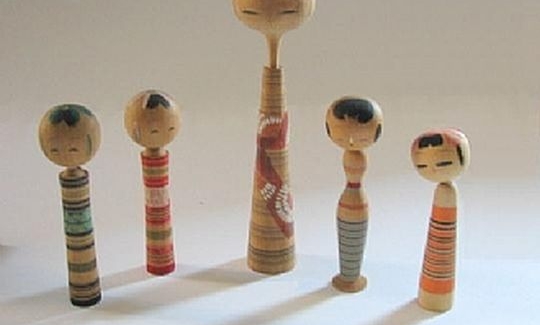Kokeshi are Japanese wooden dolls, made by hand by specialist craftsmen working in wood, or by creative artists. They originated in the district of Tohoku in north-east Japan, and are very simple, consisting of a large round head atop a relatively narrow, limbless cylindrical body. There are many variants, each area of Japan having its unique style. The early dolls were not painted, but today most of them are, in a multitude of colours, and ornamented with flowers and traditional designs. Their painted features are refined; some of them are smiling or looking mischievous, and others look serious. But although there are so many types of kokeshi, all of them are characterized by absolute perfection and simplicity - and this is the source of their charm.
The meaning of "kokeshi" is not clear. In Japanese the word can be written in Chinese characters with different meanings. The simplest explanation accepted in Japan is that the kokeshi is simply a doll (keshi) made of wood (ki, ko); or a little (ko) doll (keshi). Accordingly, it was decided at "The Great Japanese Kokeshi Conference" at Naruko in 1939, to write the word in phonetic hiragana letters.
The earliest reference to kokeshi only appears in the literature in 1965. There it is noted that the source of the word is a local expression from the town of Sendai in Miyagi Province. In Sendai they used to make terracotta dolls known as keshi-ningyo. Other names were used in other areas, such as deko, kideko, and dekoroko in Fukushima Province; kibako, kihohoko and obokko in Miyagi; and hangyo and kiningyo in Naruko.
Very little is known about the early history of kokeshi. Some researchers believe they derive from a religious custom connected with the belief that the souls of the dead enter the wooden dolls and inhabit them. It is also possible that they were made in honour and in memory of the departed. Japanese shamans (itako) invoked the spirits of the dead, during which ritual they used a doll-shaped stick without limbs (oshira-sama). So it is possible that the source of this art is the belief that stick-dolls have supernatural powers.
Two other items connected with the subject of purification may also shed light on the origins of the kokeshi. In the Shinto faith there is a strong emphasis on purity, cleanliness and beauty. Purification is achieved by means of ritual bathing (misogi) in a river, in the sea, or beneath a waterfall. All of this is conducive to a high level of personal hygiene, and to the construction of bath-houses adjacent to hot springs.
In the 12th century, a new ritual ceremony appeared in Japan, during which paper or straw dolls were prepared and then cast into the river in the belief that they would carry away diseases and bad luck. In Japan, dolls were not merely toys, but amulets protecting their makers. Perhaps the kokeshi were also endowed with ritual tasks of purification and healing. This would also explain why the kokeshi industry developed in the vicinity of the bath-houses.
According to another suggestion, the kokeshi were massaging implements with cylindrical handles and round heads that bathers used for massaging their bodies, which is why the dolls have no limbs. Later, they were modelled as pretty little boys and girls, and very quickly they were to be found all over Japan. People who could not afford porcelain dolls purchased these wooden ones, and they might also have been used as teething rings for babies. They were given as birthday presents. Farmers encouraged their children to play with kokeshi as a form of homage to the deities and in order to guarantee a successful harvest.
Initially, in 1804-1830, it was the wood carvers (kiji-shi, rokuro-shi) of Shinchi Shuraku, near the hot springs at Togatta in Zao, in Miyagi Province who made the kokeshi. From 1830 to 1844 the technique was disseminated in other bath-houses and hot springs, like Tsuchiyu in Fukushima, and Naruko in Miyagi. All kokeshi have the same basic ‘format', but each area has developed its own specific design and embellishments. As of the 1880s, it has become customary to divide the kokeshi into ten or eleven groups according to the district in which they are made, namely: Tsuchiyu, Yajiro, Togatta, Zaotakayu, Hijiori, Sakunami, Naruko, Kijiyama, Nanbu, and Tsugaru. Some consider the Yamagata as a separate category from the Sakunami and thus the eleventh group.
Originally there were only three groups - Zao, Tsuchiyu, and Naruko, and the dolls were made on a lathe turned by two people - the carver, and the turner. Later, the lathe was turned by a treadle, which allowed only one person to make the doll. Apparently the kokeshi were an extra source of income for local craftsmen who made wooden household items. During the cold winters they prepared the dolls, and sold them as souvenirs to visitors who came to the bath-houses to benefit from the hot springs.
Various woods are used for the kokeshi dolls, including cherry, Japanese maple (itaya-kaede), and mizuki which, in Japanese, means "water tree" - so that these dolls were considered as charms against fire in the old days. The timber has to be dried out for 1-5 years before it can be used.
Kokeshi dolls, until recently obtainable everywhere in Japan, have long disappeared from the bath-houses by the hot springs. They are now to be found in museums, galleries, and occasionally in shops, arousing nostalgia for Japan of the Showa period (1926-1989). In recent years there has been an increase in the number of collectors, both in Japan and abroad.
The exhibition presents modern kokeshi, from the 1950s until the present, all from the collection of Jacob Fass. Some of them have been made by well-known creative artists and some by kokeshi craftsmen according to modern designs, and sold as souvenirs.

